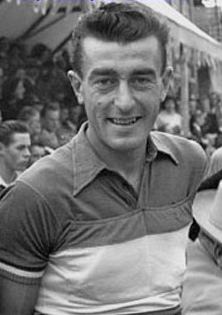 When French cyclist Louison Bobet won the Tour de France in 1953, 1954, and 1955 he became the first rider to win the event three consecutive times. His victories came through sheer hard work and determination.
When French cyclist Louison Bobet won the Tour de France in 1953, 1954, and 1955 he became the first rider to win the event three consecutive times. His victories came through sheer hard work and determination.
For example, his first Tour de France was in 1947 at the tender age of 22 he was forced to quit when the race reached the mountain stages. He found the going too tough, and it was a lesson the young Bobet would not forget. He trained even harder and became one of the greatest climbers of his era.
The following year 1948 he was the darling of the French press when he took the Yellow Jersey early in the race. However, that was the year when Italian Gino Bartali was unstoppable and came out a clear winner. (Picture below: Bobet leads Bartali.)

Bobet failed to finish the Tour in 1949, but in 1950 had his best showing to date, finishing 3rd. overall, and taking the King of the Mountains Trophy. However, this showing was somewhat tainted because the entire Italian team quit due to hostility and interference from French spectators. This was when Italian rider Fiorenzo Magni was leading the race. Swiss rider Ferdi Kubler won that year.
Naturally the French Nation expected great things of Louison Bobet the following year 1951. His year began well, Bobet won the Mountains Jersey in the Giro d’Italia. He also won two of the Classic races that year, the Milan – San Remo, and the Tour of Lombardy.
However, his showing in the Tour de France was disappointing when he placed 20th. The French press were writing him off as being a good single day rider, but not having the right stuff to win the Tour. Bobet would miss the 1952 Tour due to injury.
 In 1953 TDF Louison Bobet finally silenced his critics, and for the years that followed he became the favorite of the French Nation. 1947 winner Jean Robic took an early lead, but a crash and an all out attack by the French National Team put Robic out of the race. Louison Bobet, took the yellow jersey on the famed stage over the Izoard Pass and kept it.
In 1953 TDF Louison Bobet finally silenced his critics, and for the years that followed he became the favorite of the French Nation. 1947 winner Jean Robic took an early lead, but a crash and an all out attack by the French National Team put Robic out of the race. Louison Bobet, took the yellow jersey on the famed stage over the Izoard Pass and kept it.
In the 1954 Tour, the Swiss team led by Ferdi Kubler, Hugo Koblet and Fritz Schaer kept up constant pressure. However, as in 1953, Bobet slaughtered his rivals on the Izoard climb and cemented his second consecutive Tour victory.
For some the famed Izoard climb is synonymous with Louison Bobet. The mythic Alpine climb was crucial to his first two Tour victories. So convincing was he in 1954, he left his Swiss rival Ferdi Kubler trailing by twelve minutes.
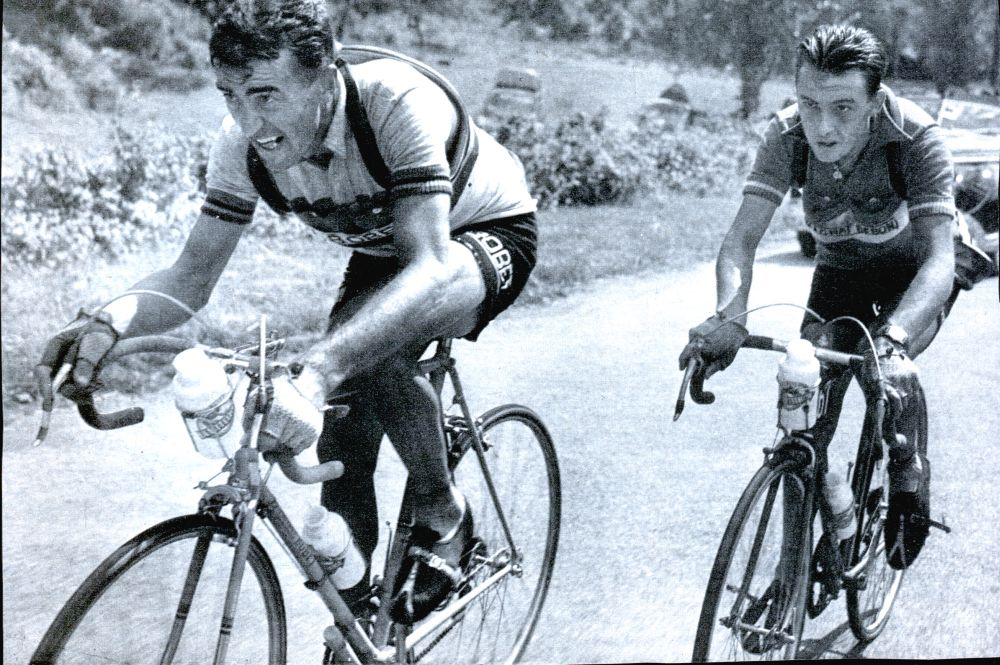
In 1955, suffering from a saddle sore, many were pessimistic about the chances of Louison Bobet winning his third consecutive Tour de France. Young Luxembourg climber Charly Gaul (Pictured above with Bobet.) grabbed plenty of headlines by winning Bobet's sacred stage to Briançon. But Bobet bounced back by destroying his competition on the feared Mount Ventoux after a long solo victory. It proved to be the key to his third Tour victory.
Bobet's victory on the Mount Ventoux was of the stuff that becomes legendary in Tour history. At the start of the stage, Bobet is still more than 11 minutes down to the unheralded Antonin Rolland. At the foot of the 21-kilometer climb, the Swiss champ attacked with Raphäel Geminiani and no one could follow. (Bobet and Geminiani picture below.)
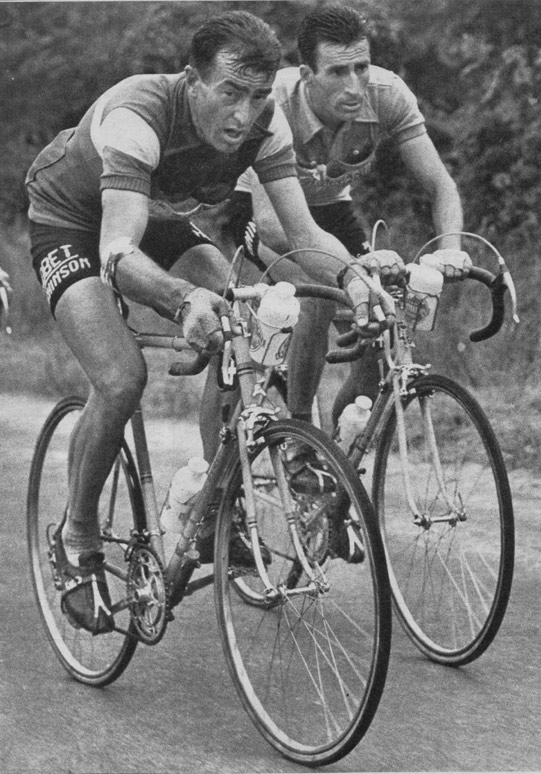
However, the Swiss misjudged the difficulty of the climb and faded badly. Bobet, who understood the true menace of the famed mountain, bided his time. In the final six kilometers, above the tree line in under the blazing sun, Bobet caught and passed the leaders. No one could match his driving pace. At the summit Kubler was already 20 minutes down and by the finish in Avignon, Bobet was alone.
By his own admission Bobet was never the same after the 1955 Tour. However, he did win the Paris-Roubaix Classic in 1956. He had placed 3rd in 1955, and had previously placed 2nd in 1951. Louison Bobet won the World Championship Road Race in 1954, was 2nd in 1957 and 1958.
Bobet’s career was effectively ended in December 1961 when his car skidded off the road and hit a boulder. Bobet broke his femur and his recovery was long and difficult. He eventually raced again, but retired the next year at the end of 1962.
Born 1925, Louison Bobet died of cancer in 1983 at the young age of 58. After his death, there was speculation that the saddle sore that had plagued him in his last Tour win, was much more than a simple boil, and may have been cancer. In the 1950s cancer was a taboo subject and no one talked of it. If that was the case, his win showed the sheer guts and determination of the man.
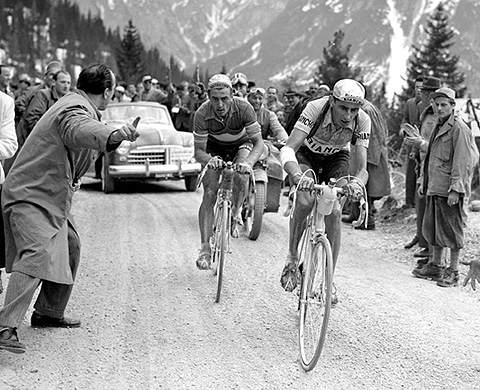
Bobet’s Tour victories came between Fausto Coppi (Above leading Bobet.) and Jacques Anquetil, both men spoke highly of him. Coppi once said of Bobet. “He knows like nobody else how to suffer and his powers of recovery are unmatched. The bike means everything to him. It is truly his life blood and his application to his chosen way of life is an example to every aspiring champion.”
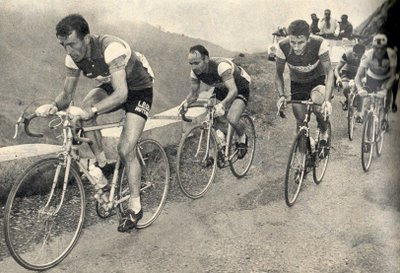
Anquetil (Above 3rd from left, with Bobet leading.) stated “In Bobet’s eyes there were no little races or unimportant victories. Every race mattered and he wanted to give his everything to his public. Bobet knew only one way of racing and that was to race to win, whatever the sacrifices demanded.”
These quotes reflect the respect and admiration of fellow riders and the public. He was certainly one of the heroes of my youth.
 Thu, March 26, 2009
Thu, March 26, 2009 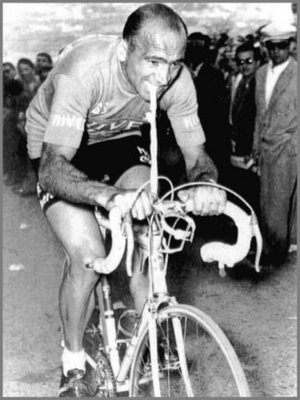 A fractured clavicle, (Collarbone.) is in the news at this time due to
A fractured clavicle, (Collarbone.) is in the news at this time due to Dave Moulton | Comments Off |
Dave Moulton | Comments Off | 
























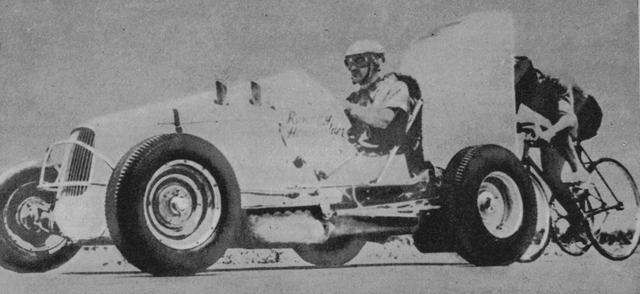
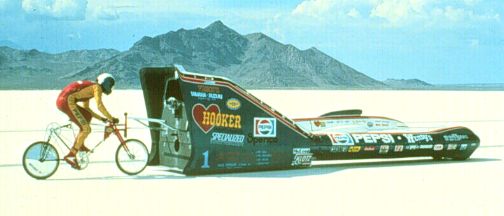
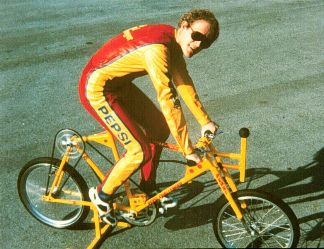

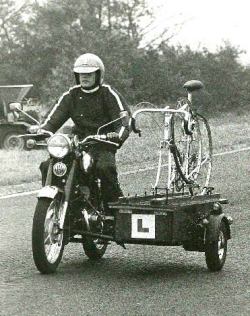
 The picture above is of me riding in the National Championship
The picture above is of me riding in the National Championship 